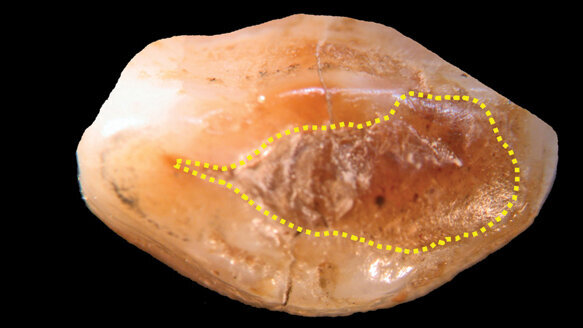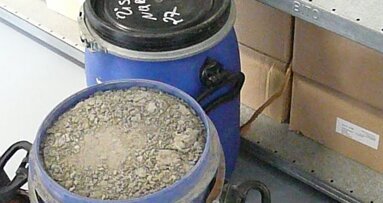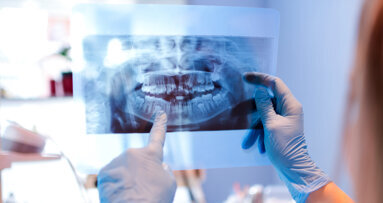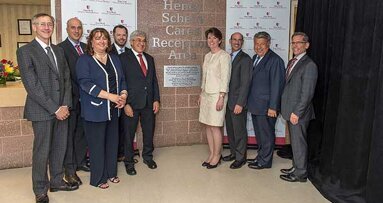SAN FRANCISCO, Calif., USA: A team of Italian and Australian researches appears to have found physical proof that restorative dentistry dates to the Stone Age. The researchers identified traces of a dental filling made of beeswax in a Neolithic human tooth discovered in Slovenia, and they are saying it may be the “earliest known direct evidence of [a] therapeutic-palliative dental filling.”
The research findings were published Sept. 19 in PLoS ONE, the peer-reviewed, open-access journal, accessible at www.plosone.org.
The team acknowledges in its paper that it cannot be absolutely certain that the beeswax filling was placed in the tooth in an effort to address a dental problem the individual was experiencing while alive. But the paper identifies that as being the most likely of the possible scenarios that would explain the presence of the substance on a worn-down tooth that otherwise would have had exposed dentin.
“The tooth probably became very sensitive, limiting the functionality of the jaw during occlusion. The occlusal surface could have been filled with beeswax in an attempt to reduce the pain [by] sealing exposed dentin tubules and the fracture from changes in osmotic pressure (as occurs on contact with sugar) and temperature (hot or cold relative to the oral cavity),” the team wrote.
The piece of jawbone with five teeth still attached was discovered long before the team’s research was conducted. It was excavated from a cave wall near the village of Loche, Istria, in Slovenia and was initially dated based on associated fauna remains, which traced to the Upper Pleistocene era.
The team reported that the specimen was considered to be “one of the most ancient anthropological remains from the northern-Adriatic area.” But the find had never been subjected to detailed analysis until the researchers secured permission to study the mandible using state-of-the-art scanning technology and radiocarbon dating techniques.
Permission was granted by Italy’s Natural History Museum of Trieste, to whom the original finders had donated the specimen. The mandible, determined to be from a male who died in his 20s, was described by the team as, “the left portion of an isolated adult mandible bearing a canine, two premolars, and the first two molars.”
The 12-person team of researchers from university and governmental facilities in Italy and Australia used synchrotron radiation computed microtomography, accelerator mass spectrometry radiocarbon dating, infrared spectroscopy and scanning electron microscopy to separately analyze the tooth, bone and filling material.
Based on the radiocarbon analysis, the mandible was dated to an age range of 6,655–6,400 years Before Present and the filling 6,645–6,440 years BP.
The researchers listed several previously known examples of ancient dentistry but said there was no known published documentation of the use of “therapeutic palliative substance in prehistoric dentistry.” The research team also referenced documentation on the use of beeswax as a binding agent in antiquity -— and explained the substance’s ability to remain preserved for long periods of time because of its “extreme chemical stability.”
The team's conclusion: “In this emerging framework of ancient dental therapeutic practices, the finding of a human partial mandible associated with contemporary beeswax, covering the occlusal surface of a canine, could represent a possible case of therapeutic use of beeswax during the Neolithic.”
In a note regarding the funding of the research project, the team wrote, “This work is part of the ICTP/Elettra EXACT Project (Elemental X-ray Analysis and Computed Tomography) funded by Friuli Venezia Giulia (Italy). The funders had no role in study design, data collection and analysis, decision to publish, or preparation of the manuscript.”
The team’s paper is titled, “Beeswax as Dental Filling on a Neolithic Human Tooth.”
(Source: Plos One, www.plosone.org, Sept. 19, 2012, Vol. 7, Issue 9 e44904)
Running a dental practice is a multifaceted endeavour that requires not only excellent clinical knowledge but also a solid understanding of business. In ...
WASHINGTON, DC, USA: The US Food and Drug Administration said silver-coloured dental fillings that contain mercury are safe for patients, reversing an ...
NEW YORK, NY, USA: The health of the surrounding tissue affects the success of a dental implant. Identifying and reducing risk factors is therefore a key ...
SANTA BARBARA, CA, USA: A unique dental program in Afghanistan is saving lives, raising the infrastructure level and bringing about social change for women ...
PHILADELPHIA, US: It was previously believed that Streptococcus mutans was the main microorganism responsible for dental caries. However, in a recent study,...
BOSTON, US: VideaHealth, a provider of artificial intelligence (AI)-powered dental technology, has introduced OrthoAI and ImplantAI—new features within ...
Augusta, GA, USA: A US research project is currently investigating a new technique that may extend the longevity of dental fillings. Dr Franklin Tay, ...
Pittsburgh, PA, USA: Researchers at the University of Pittsburgh have developed a quick and simple method for detecting mercury in fish and dental samples, ...
MELVILLE, N.Y., USA: Stanley M. Bergman, chairman of the board and CEO of Henry Schein Inc., recently delivered the commencement address at Stony Brook ...
MELVILLE, N.Y., USA: Stony Brook University (SBU) School of Dental Medicine and Henry Schein Inc. recently unveiled the new Henry Schein Cares Reception ...
Live webinar
Wed. 14 January 2026
12:00 PM EST (New York)
Dr. Théo Laplane, Dr. Robert Gottlander DDS
Live webinar
Fri. 16 January 2026
12:00 PM EST (New York)
Live webinar
Mon. 19 January 2026
1:00 PM EST (New York)
Philipp Kopp, Michael Seeber
Live webinar
Thu. 22 January 2026
9:00 AM EST (New York)
Prof. Judith Jones D.D.S; M.P.H., Prof. Kakuhiro Fukai D.D.S., Ph.D, Dr. Bathsheba (Bethy) Turton
Live webinar
Thu. 22 January 2026
2:00 PM EST (New York)
Dr. Nicola M. Grande DDS, PhD
Live webinar
Wed. 28 January 2026
8:00 AM EST (New York)
Live webinar
Wed. 28 January 2026
11:00 AM EST (New York)
Prof. Dr. Jan-Frederik Güth



 Austria / Österreich
Austria / Österreich
 Bosnia and Herzegovina / Босна и Херцеговина
Bosnia and Herzegovina / Босна и Херцеговина
 Bulgaria / България
Bulgaria / България
 Croatia / Hrvatska
Croatia / Hrvatska
 Czech Republic & Slovakia / Česká republika & Slovensko
Czech Republic & Slovakia / Česká republika & Slovensko
 France / France
France / France
 Germany / Deutschland
Germany / Deutschland
 Greece / ΕΛΛΑΔΑ
Greece / ΕΛΛΑΔΑ
 Hungary / Hungary
Hungary / Hungary
 Italy / Italia
Italy / Italia
 Netherlands / Nederland
Netherlands / Nederland
 Nordic / Nordic
Nordic / Nordic
 Poland / Polska
Poland / Polska
 Portugal / Portugal
Portugal / Portugal
 Romania & Moldova / România & Moldova
Romania & Moldova / România & Moldova
 Slovenia / Slovenija
Slovenia / Slovenija
 Serbia & Montenegro / Србија и Црна Гора
Serbia & Montenegro / Србија и Црна Гора
 Spain / España
Spain / España
 Switzerland / Schweiz
Switzerland / Schweiz
 Turkey / Türkiye
Turkey / Türkiye
 UK & Ireland / UK & Ireland
UK & Ireland / UK & Ireland
 International / International
International / International
 Brazil / Brasil
Brazil / Brasil
 Canada / Canada
Canada / Canada
 Latin America / Latinoamérica
Latin America / Latinoamérica
 China / 中国
China / 中国
 India / भारत गणराज्य
India / भारत गणराज्य
 Pakistan / Pākistān
Pakistan / Pākistān
 Vietnam / Việt Nam
Vietnam / Việt Nam
 ASEAN / ASEAN
ASEAN / ASEAN
 Israel / מְדִינַת יִשְׂרָאֵל
Israel / מְדִינַת יִשְׂרָאֵל
 Algeria, Morocco & Tunisia / الجزائر والمغرب وتونس
Algeria, Morocco & Tunisia / الجزائر والمغرب وتونس
 Middle East / Middle East
Middle East / Middle East





























































To post a reply please login or register